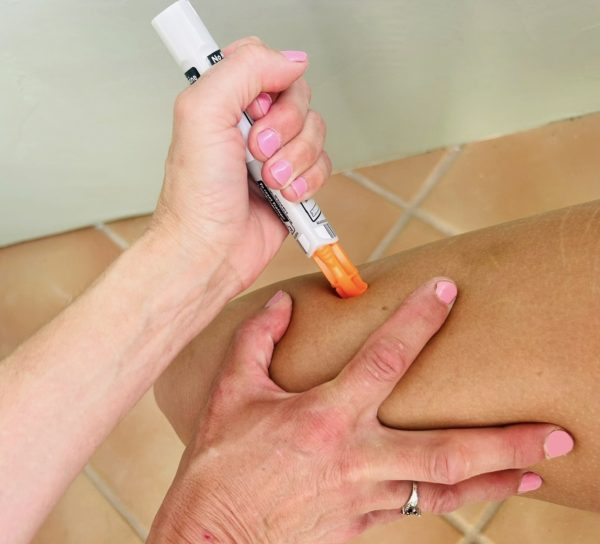A five-year-old student sits alone at the “peanut-free table” in her kindergarten class and starts eating her lunch in sadness. While she may be sad sitting alone, eating lunch at this table protects her from the devastating consequences that may arise from a reaction due to a peanut allergy. According to the Centers for Disease Control and Prevention (CDC), an estimated 8% of students in a classroom have a food allergy. A food allergy happens when one’s body negatively reacts to certain foods, resulting in symptoms such as hives, rashes, anaphylaxis, swelling, and wheezing. As students progress through each grade level, their responsibility to monitor their allergy increases. For these students, their allergies affect many aspects of their lives, as it is their responsibility to ensure their safety and well-being.
One of the responsibilities this group holds is carrying an auto-injector, EpiPen. Epinephrine is used during a severe allergic reaction, usually one that involves anaphylaxis. An EpiPen combats reactions by stopping chemicals from being released, therefore stopping reaction symptoms.
“When you’re in high school, usually the student holds [an EpiPen] in their backpack,” school nurse Cameron Epley said.
When students are younger, it is typically the responsibility of a teacher, parent, or nurse to keep track of the child’s EpiPen. However, as students age, the responsibility becomes theirs.
“We always know that it’s going to be in their backpack, and it is the student’s responsibility to have it in there,” Epley said.
If the students fail to carry their EpiPen, they are at greater health risk. To aid in this, bill SB 1266 was passed in 2015, requiring schools to keep stock epinephrine on campus. This means that if a student forgot their EpiPen or was unaware of their allergy, their lives could be saved by a stock EpiPen on campus.
“We have to be able to have that (Epinephrine) ready and supplied and have staff members trained,” Epely said.

While EpiPens provide a life-saving medication, students still have to take precautions to protect themselves from a reaction. No matter where the student is, precautions must be taken in order to ensure their safety.
“I work in a fish [restaurant], so I am constantly asking the chefs if the [food] could have been in contact with fish,” Amelia Pfost (‘26), who has a fish and sunscreen allergy, said. “Everywhere I go, I have to make sure there is no way [fish] touched the food I am eating.”
The effort required to ensure one’s well-being often leads students to feel left out, even from a young age.
“In my elementary school, we had a peanut-free table, and I was the only student who had to sit there,” Rosa Ibarra (‘26), who has a peanut allergy, said. “It was not fun.”
In addition to feeling excluded, having a food allergy often means dealing with painful symptoms and excessive sensitivity to the world around.
“[Having an allergy] is honestly horrible,” Ibarra said. “I feel like when you’re allergic to a certain thing, you’re allergic to everything.”
Even with exclusions and precautions made, severe allergies can still have harmful effects on students.
“I went into the beach or pool knowing that I was going to be covered in rashes by the end of the day,” Pfost said. “I have to move myself out of the way when people spray sunscreen. It’s a responsibility on myself to make sure I don’t die.”
Though the fear of an accidental exposure is ever present in their minds, individuals still manage to participate in the world around them.








